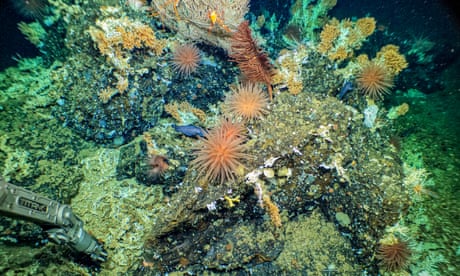- by foxnews
- 26 Nov 2024
Scientists discover pristine deep-sea Galápagos reef ‘teeming with life’
Scientists discover pristine deep-sea Galápagos reef ‘teeming with life’
- by theguardian
- 19 Apr 2023
- in news

Diving to depths of 600 metres (1,970ft), to the summit of a previously unmapped seamount in the central part of the archipelago, the scientists witnessed a breathtaking mix of deep marine life. This has raised hopes that healthy reefs can still thrive at a time when coral is in crisis due to record sea surface temperatures and ocean acidification. It also showed the effectiveness of conservation actions and effective management, they said.
"They are pristine and teeming with life - pink octopus, batfish, squat lobsters and an array of deep-sea fish, sharks and rays," said Dr Michelle Taylor, a marine biologist at Essex University and co-leader of the expedition in a human-occupied vehicle, HOV Alvin, a submersible able to take two scientists to depths of 6,500 metres.
The country is collaborating with its northern neighbours Panama, Costa Rica and Colombia on a regional marine corridor initiative, which aims to protect and responsibly manage the ocean.
Operated by Taylor and Dr Stuart Banks, of the Charles Darwin Foundation in Ecuador, HOV Alvin explored unknown regions of the reserve using state-of-the-art sampling capabilities and visual upgrades that included improved high-quality still and ultra-high-definition 4K video-imaging systems.
"These newly discovered reefs are potentially of global significance - a 'canary in the mine' for other reefs globally - sites which we can monitor over time to see how pristine habitats evolve with our current climate crisis," Taylor said.
Banks said the reef helped scientists "reconstruct past ocean environments to understand modern climate change". It could also help understand the role of MPAs in the carbon cycle and fisheries. "It's very likely there are more reef structures across different depths waiting to be explored," he said.
A newly established MPA, the Hermandad marine reserve, now connects a chain of seamounts in Ecuadorian waters to offshore marine environments such as Costa Rica's Cocos Island national park. Scientists say the underwater mountains are migratory routes for marine life and require special measures to protect foraging grounds and sustain responsible fisheries.
HOV Alvin is owned by the US navy and operated by the Woods Hole Oceanographic Institution (WHOI), as part of the US National Science Foundation-funded National Deep Submergence Facility. It was also financed by the Natural Environmental Research Council in the UK.
- by foxnews
- descember 09, 2016
The world's oldest Douglas fir trees have lived over 1,000 years
The Douglas fir, the state tree of Oregon, can grow incredibly tall and live impressively long. The oldest Douglas fir trees have lived to be over 1,000 years old.
read more


